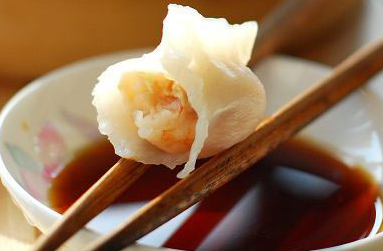Taste of old Beijing snacks
 Beijing's snacks are a special treat that should not be overlooked. The adventurous should certainly try specialties such as bean juice served with fried rolls, niangao, aiwowo and guanchang when visiting temple fairs or with a local family during the Spring Festival.
Beijing's snacks are a special treat that should not be overlooked. The adventurous should certainly try specialties such as bean juice served with fried rolls, niangao, aiwowo and guanchang when visiting temple fairs or with a local family during the Spring Festival.
"Old Beijingers" have long-relished two kinds of snacks: bean juice (douzhi) and fried rolls (jiaoquan). Bean juice was produced during the Song Dynasty (960-1279) and is rich in protein, vitamin C, fibre and sugar. It is valued medicinally, because the concoction can reportedly reduce internal heat and toxins. The fried rolls that are always eaten with the bean juice will remain crisp, if stored, for up to ten days.
Since the Liao Dynasty (916-1125), people have eaten niangao, made of sticky rice, on the first day of the year in the lunar calendar. It symbolizes that life in the following years will get better and better.
Aiwowo, made of sticky rice, sesame seeds, peach kernels, melon seeds and sugar, was snack beloved by the laobaixing (common people) and the imperial families of the Ming Dynasty (1368-1644). Guanchang, sometimes cooked at home, is a snack made of flower and is dipped into garlic juice. It can be easily found at temple fairs and snack stores.
For some travellers experiencing the real lives of the people they encounter in their travels is far more important than grand welcomes or sumptuous banquets.
But how do you best experience the local lives of Beijingers?
One way is to head to the Duyichu Restaurant, “The Single Place of the Capital.” Located in Building 15, Third District, Fangchengyuan, in Fengtai District, Duyichu, a China Time Honoured Brand (Zhongguo Laozihao) is now surrounded by skyscrapers and other restaurants, but its shop sign bears signs of the character that has allowed Duyichu to continue operating peacefully for nearly 260 years.
The Duyichu Restaurant was initially built in the third year (1738) of the reign of Emperor Qianlong of the Qing Dynasty (1644–1911). But at that time, the humble restaurant established by Wang Ruifu, a man from ShanxiProvince, had no official name. It was marked only by a cluster of gourds hanging by its door, its sign. The name Duyichu was granted by Emperor Qianlong, and a signboard signed by the emperor remains well-preserved in the restaurant.
This story begins during a deep night on Chuxi or Lunar New Year’s Eve in 1752. Emperor Qianlong had just returned from a secret visit to Tongzhou (then the remote countryside) and he and his two attendants were hungry and cold. But they could not found a restaurant; all the shops were closed for the New Year. Then they spotted a sputtering lamplight in a small shop.
In the shop, Qianlong had a good dinner that soothed his soul. He was content with the entertainment of the landlord and asked the name of the restaurant, but it had no name. After a time, the emperor left. The following day, to Wang’s surprise, a signboard with the name Duyichu was delivered to his shop, sent by some palace officials. The name meant “the only restaurant in the capital.” It was then that Wang learned that the party he had entertained included the emperor himself, winning the name of his restaurant and the prosperity that came with it. Many people came to the restaurant to view the signboard and to taste the food that had been praised by the emperor. This happens even today.
But the Duyichu Restaurant’s reputation might be undeserved in contemporary times were it not for its high-quality cuisine and its snacks that have been famed for hundreds of years. Its main products are shaomai (a kind of steamed dumplings), malian meat (pork braised with malian grass), deep-fried-triangle steamed buns and other cuisines of Shandong and Beijing.
Almost every customer that arrives at Duyichu Restaurant expects to dine on shaomai, and when it’s placed on the table, people usually admire its attractive, lotus-flower shaped morsels. It’s amazing that a little snack like this can carry a restaurant through thick and thin for hundreds of years. But that’s how special Duyichu's shaomai is, a snack that requires 16 discrete processes all completely by hand. Meticulous preparation is found in every step of the process, from the making of dough with boiling water, the mixture of the stuffing, the rolling of the dough sheet and even the wrapping procedure. Watching the preparations, you just want to reach out and bite into them, and when you finally do eat them their taste is irresistible. But there’s also great variation in the snacks, with the dumpling’s fillings changing with the seasons. There are at least 30 different tastes to sample.
The deep-fried triangle steamed bun is made of flour and cold, lean, pot-stewed meat. Cooks fill the dough sheets with stuffing, pinch them into a triangle shape and fry them in oil. When eating, it’s best to poke a hole on the sheet with a chopstick to release trapped steam; then suck out the dumpling’s dainty meat extract, tasting its delicate softness.
Summertime dooms the making of deep-fried triangle steamed buns because its dough should not be fermented too quickly, which happens in the heat. It is a dish for a season, but Duyichu’s shaomai is a constant standard.
The making of malian meat is also a time-consuming. Fine, streaky pork should be cut carefully into strips with knife, retaining and wrapping the fat meat around the lean meat. It is then salted and wrapped with malian grass and stored for two–eight hours, with eight being the best. Meat should be boiled in seasoning, then cooled into a meat jelly. Afterwards you will get a chance to taste the snack masterpiece. The smoothness and fragility of the meat with the slight addition of the malian grass’s flavour will please you completely.
Make this a leisurely outing, and take time to taste all kinds of Duyichu’s snacks, while enjoying its old Beijing ambience and the wonderful people who serve and dine with you.






